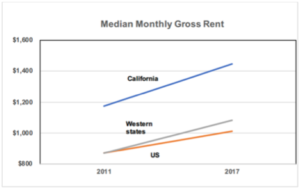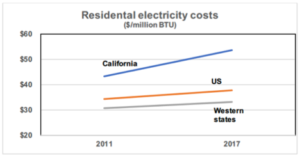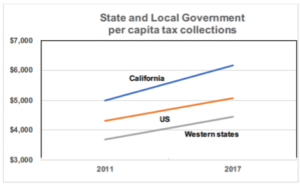Yesterday I wrote of the persistent paradox in California: a state enjoying great economic success suffering depopulation by middle class and working residents. Today I identify some of the key affordability issues and how elected officials can address them.
Housing
California’s infamous housing crisis lies at the center of much of the state’s ills, from our high poverty rate, intractable homelessness, and flight of middle-class workers and jobs. Lack of affordable housing remains one of the largest threats to California’s otherwise booming economy.
California renters pay 40 percent more in median rent than the rest of the US, and median home listings are double the US average. California has the lowest housing vacancy rate in the nation, and a third of young adults, aged 25 – 29, are living at home with their parents.

California cannot maintain its economic growth and broaden opportunities for citizens of all skill and income levels without committing to a rapid increase in the supply of housing and growing jobs near affordable market rate housing.
Solutions: Elected leaders can moderate the supply-induced affordability squeeze by capping local housing fees, reinstating tax increment financing for targeted economic development to help pay for local infrastructure and housing, reshaping state-local tax sharing to reduce disincentives to approve new housing, quashing further attempts at rent control, reforming CEQA to remove litigation cost premiums on new housing, and improving highway and transit capacity for new housing to ease the commute for homeowners unable to afford expensive coastal or urban housing.
Utilities
Californians are paying the highest and fastest-rising residential electricity costs in the nation. Our residential electricity costs are 42 percent higher than the national average, and since 2011 have increased more than twice as fast as the rest of the nation. Cost to residents in other Western states tend to be below the national average and have increased only slightly since 2011.

California is also an outlier for electricity costs for commercial customers: 47 percent higher than the national average, increasing more than four times faster than costs nationally.
Solutions: Elected leaders can moderate rapid growth in Californians’ energy costs by throttling back the sprint toward pricey CO2 reductions whose costs have landed on ratepayers and motorists, but whose benefits have been difficult to measure, and by permitting development of in-state energy sources that are clean, price-competitive, or that would simply be replaced by dirtier or less secure offshore sources.
Commuting to work
Owning, operating and spending time in a car is a major expense for California workers. Even after decades of investment in alternative options, more than eight out of ten California workers drive to work alone in a private automobile. About 75% of commuters drive alone, 10 percent use an automobile to carpool, while about five percent each regularly use public transit, use other non-automobile options, or work from home.
Commute modes vary substantially depending on where the commuter lives and works. Commute times are much longer in California than elsewhere. Drivers spend about 25 percent more time to get to work in California than the average of other western states. Four of the ten longest commutes in the country are in California – notably driving to and from outlying regions to the Bay Area or Southern California job centers.
Long commutes by automobile mean substantial fuel consumption. Californians continue to lead the nation in purchasing and using cars that use alternative fuels – for good reason. The cost of gasoline in California persistently tops the nation, no matter when on the oil price cycle.
For the past nine years for all grades of gasoline, California’s price per gallon averaged 12 percent higher than other west coast states, and 25 percent higher than Rocky Mountain states.
Solutions: Elected leaders can mitigate commute costs by reforming some of the extra costs placed on fuels, including unnecessary premiums from the cost of climate regulations (e.g., low carbon fuel standard), resist higher taxes on domestically-produced oil, and encouraging job creation closer to where commuters actually live.
Taxes
Californians pay among the highest rates for many general taxes, including the steepest and most progressive personal income tax, very high state and local sales taxes, high gasoline and diesel taxes, and steep local business and utility taxes.
Taken together, these tax rates propel per capita state and local collections in California far above national averages and our neighboring states. While the income tax falls mostly on high income earners, all other state and local taxes do not discriminate on the basis of income and wealth. The consequences of the proliferation and growth of state and local taxes is to burden working Californians with more costs simply to live, drive, work and consume in the state.


